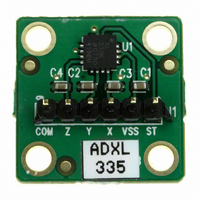EVAL-ADXL330Z Analog Devices Inc, EVAL-ADXL330Z Datasheet - Page 12

EVAL-ADXL330Z
Manufacturer Part Number
EVAL-ADXL330Z
Description
Three-Axis Accelerometer Evaluation Board
Manufacturer
Analog Devices Inc
Series
iMEMS®r
Specifications of EVAL-ADXL330Z
Silicon Manufacturer
Analog Devices
Application Sub Type
Accelerometer - Three-Axis
Kit Application Type
Sensing - Motion / Vibration / Shock
Silicon Core Number
ADXL330
Sensor Type
Accelerometer, 3 Axis
Sensing Range
±3.6g
Interface
Analog
Sensitivity
300mV/g
Voltage - Supply
1.8 V ~ 3.6 V
Embedded
No
Utilized Ic / Part
ADXL330
Lead Free Status / RoHS Status
Lead free / RoHS Compliant
Lead Free Status / RoHS Status
Lead free / RoHS Compliant, Lead free / RoHS Compliant
Other names
Q2904641
ADXL330
APPLICATIONS
POWER SUPPLY DECOUPLING
For most applications, a single 0.1 μF capacitor, C
close to the ADXL330 supply pins adequately decouples the
accelerometer from noise on the power supply. However, in
applications where noise is present at the 50 kHz internal clock
frequency (or any harmonic thereof), additional care in power
supply bypassing is required as this noise can cause errors in
acceleration measurement. If additional decoupling is needed,
a 100 Ω (or smaller) resistor or ferrite bead can be inserted in
the supply line. Additionally, a larger bulk bypass capacitor
(1 μF or greater) can be added in parallel to C
the connection from the ADXL330 ground to the power supply
ground is low impedance because noise transmitted through
ground has a similar effect as noise transmitted through V
SETTING THE BANDWIDTH USING C
The ADXL330 has provisions for band limiting the X
and Z
implement low-pass filtering for antialiasing and noise
reduction. The equation for the 3 dB bandwidth is
or more simply
The tolerance of the internal resistor (R
much as ±15% of its nominal value (32 kΩ), and the bandwidth
varies accordingly. A minimum capacitance of 0.0047 μF for C
C
Table 5. Filter Capacitor Selection, C
Bandwidth (Hz)
1
10
50
100
200
500
SELF TEST
The ST pin controls the self test feature. When this pin is set to
V
The resulting movement of the beam allows the user to test if
the accelerometer is functional. The typical change in output is
−500 mg (corresponding to −150 mV) in the X-axis, 500 mg (or
150 mV) on the Y-axis, and −200 mg (or −60 mV) on the Z-axis.
This ST pin may be left open circuit or connected to common
(COM) in normal use.
Y
S
, an electrostatic force is exerted on the accelerometer beam.
, and C
F
F
OUT
−3 dB
–3 dB
pins. Capacitors must be added at these pins to
Z
= 5 μF/C
= 1/(2π(32 kΩ) × C
is recommended in all cases.
(X, Y, Z)
(X, Y, Z)
)
Capacitor (μF)
4.7
0.47
0.10
0.05
0.027
0.01
X
FILT
, C
) typically varies as
Y
, and C
X
DC
, C
. Ensure that
DC
Y
, AND C
Z
, placed
OUT
, Y
S
.
OUT
Z
Rev. A | Page 12 of 16
,
X
,
Never expose the ST pin to voltages greater than V
this cannot be guaranteed due to the system design (for
instance, if there are multiple supply voltages), then a low V
clamping diode between ST and V
DESIGN TRADE-OFFS FOR SELECTING FILTER
CHARACTERISTICS: THE NOISE/BW TRADE-OFF
The selected accelerometer bandwidth ultimately determines
the measurement resolution (smallest detectable acceleration).
Filtering can be used to lower the noise floor to improve the
resolution of the accelerometer. Resolution is dependent on the
analog filter bandwidth at X
The output of the ADXL330 has a typical bandwidth of greater
than 500 Hz. The user must filter the signal at this point to limit
aliasing errors. The analog bandwidth must be no more than
half the analog-to-digital sampling frequency to minimize
aliasing. The analog bandwidth can be further decreased to
reduce noise and improve resolution.
The ADXL330 noise has the characteristics of white Gaussian
noise, which contributes equally at all frequencies and is
described in terms of μg/√Hz (the noise is proportional to the
square root of the accelerometer bandwidth). The user should
limit bandwidth to the lowest frequency needed by the applica-
tion to maximize the resolution and dynamic range of the
accelerometer.
With the single-pole, roll-off characteristic, the typical noise of
the ADXL330 is determined by
Often, the peak value of the noise is desired. Peak-to-peak noise
can only be estimated by statistical methods. Table 6 is useful
for estimating the probabilities of exceeding various peak
values, given the rms value.
Table 6. Estimation of Peak-to-Peak Noise
Peak-to-Peak Value
2 × rms
4 × rms
6 × rms
8 × rms
USE WITH OPERATING VOLTAGES OTHER THAN 3 V
The ADXL330 is tested and specified at V
can be powered with V
that some performance parameters change as the supply voltage
is varied.
rms
Noise
=
Noise
S
Density
as low as 1.8 V or as high as 3.6 V. Note
% of Time that Noise Exceeds
Nominal Peak-to-Peak Value
32
4.6
0.27
0.006
OUT
, Y
×
OUT
(
S
is recommended.
BW
, and Z
×
S
1.6
= 3 V; however, it
OUT
)
.
S
+ 0.3 V. If
F
















